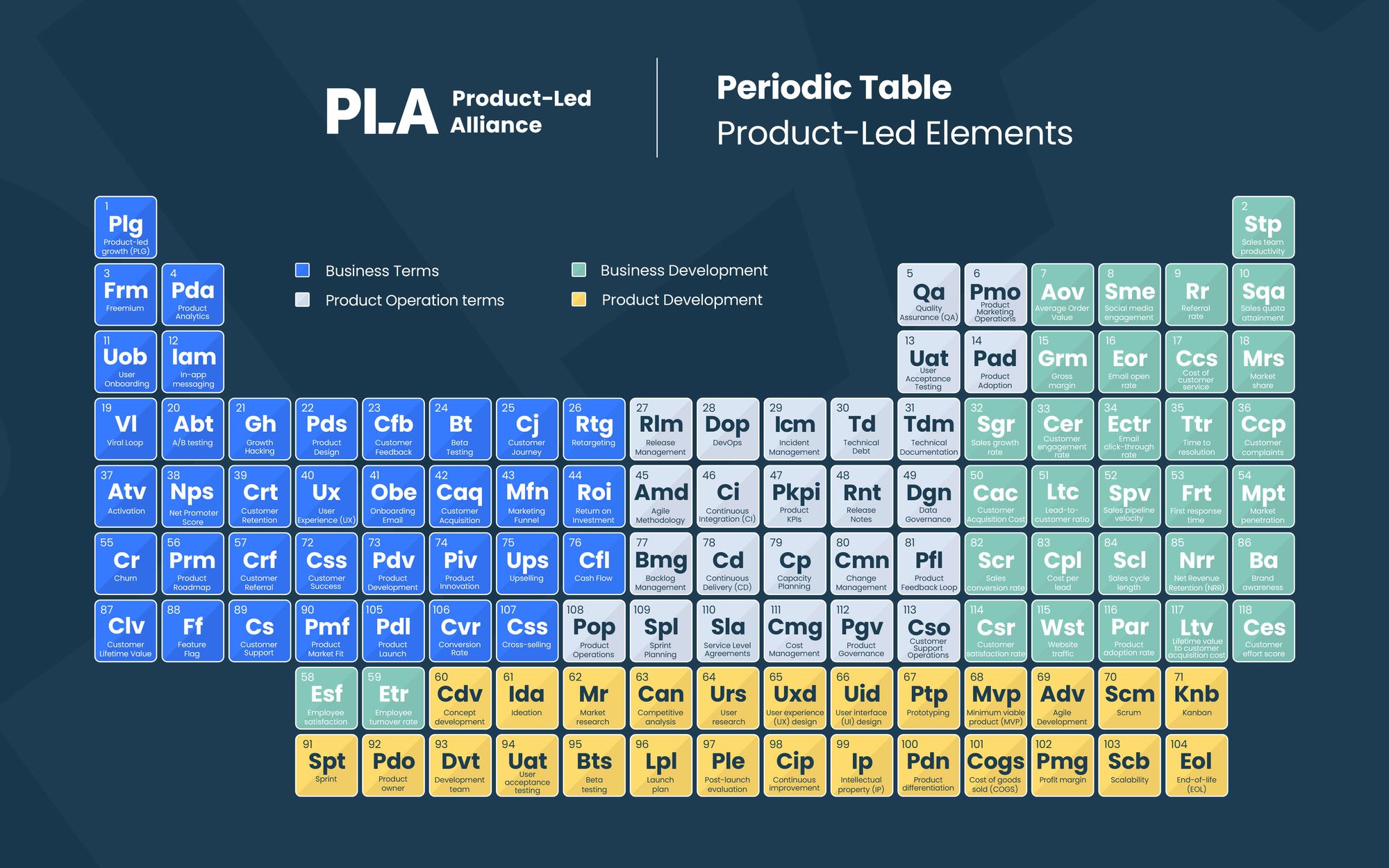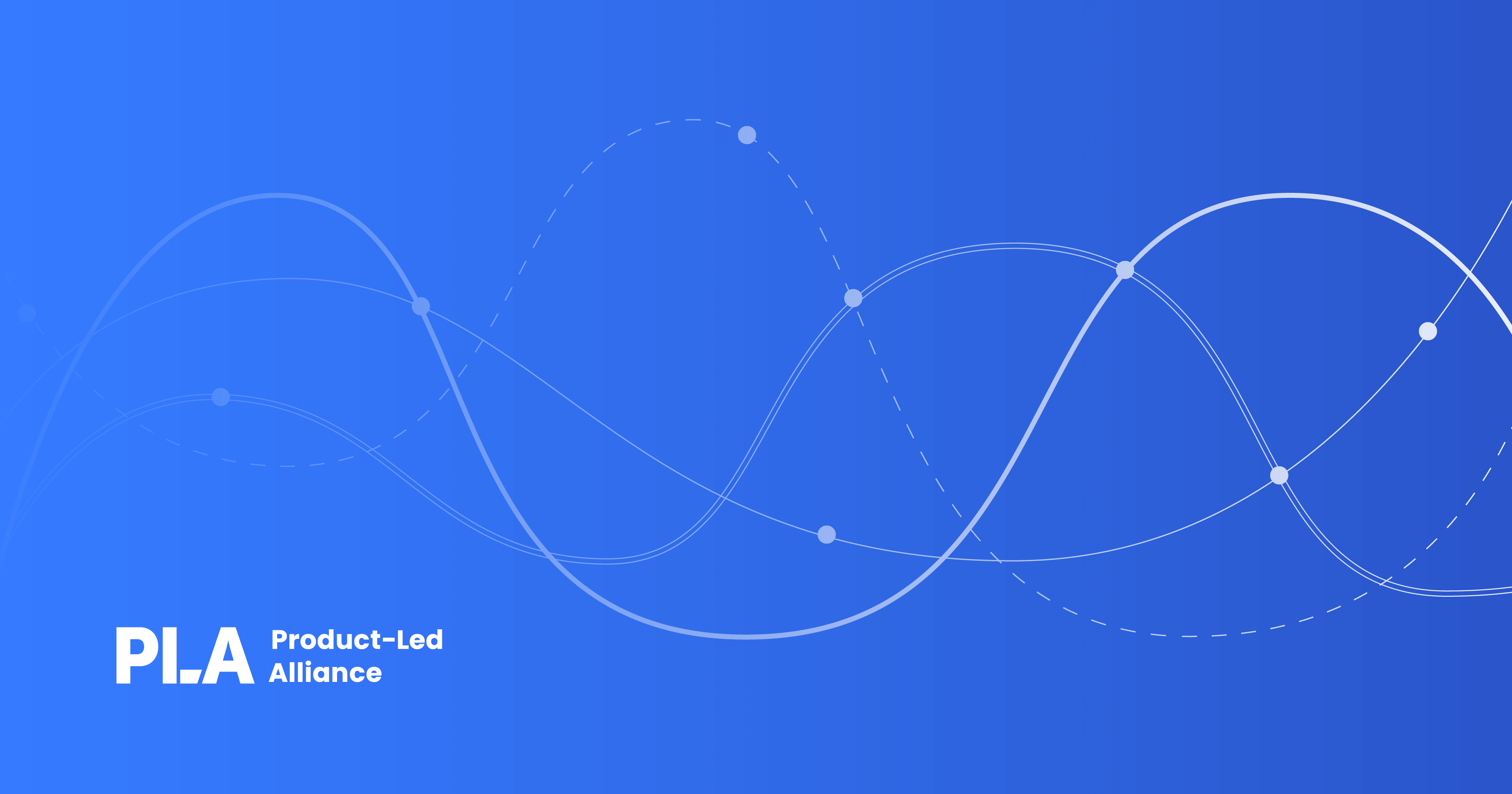Tired of feeling lost in a sea of business jargon? With so many terms out there, it can get a little confusing when it comes to product-led growth. But don’t worry because we've laid it out all for you!
Learning all the different words for PLG may seem like diving into a linguistic maze, but trust us, it's worth every effort. When you unravel the intricacies of PLG terminology, you'll unlock a whole new level of business acceleration that will leave your competitors in the dust.
We’ve created an entire periodic table of PLG terms so you can effortlessly converse with industry experts on everything from user onboarding, to funnels, freemium models, and conversions. With these terms rolling off your tongue, you'll become a magnet for success, attracting customers and stakeholders alike.
So, download the table today. What are you waiting for?

Business Terms
Plg 1: Product-led growth - A strategy that markets the product itself for customer acquisition, retention, and expansion.
Frm 3: Freemium - A pricing strategy where a product is offered with limited features for free, but additional features come with a price.
Uob 11: User Onboarding - The process of guiding new users to use and understand how a product or service works.
Vl 19: Viral Loop - A mechanism that drives users to refer a product to other users, creating a self-sustaining system.
Atv 37: Activation - When a customer becomes an active user of a product.
Cr 55: Churn - The rate at which customers stop using a product or quit a service.
Clv 87: Customer Lifetime Value - The total amount a customer is expected to spend on a product or service over the business relationship.
Pda 4: Product Analytics - Analyzing how users engage with products to improve business decisions.
Iam 12: In-app messaging - Messages delivered to a customer while they are actively using the app.
Abt 20: A/B testing - Comparing two versions of a product or service to see which performs better or needs improvement.
Nps 38: Net Promoter Score - Measures customer loyalty through a survey.
Prm 56: Product Roadmap - A visual outline of a product's vision and direction for development.

Ff 88: Feature Flag - Software that enables turning certain features on or off during in-app usage without modifying the source code.
Gh 21: Growth Hacking - Cost-effective and creative strategies to help a business grow.
Crt 39: Customer Retention - The rate of keeping customers over a period of time.
Crf 57: Customer Referral - When an existing customer recommends a product or service to a potential new customer.
Cs 89: Customer Support - A range of services to assist users who experience problems with a product or service.
Pds 22: Product Design - The process of conceptualizing and creating the look of a product to solve user needs.
Ux 40: User Experience - All aspects of a customer’s experience with a service or product.
Css 72: Customer Success - Ensuring customers reach their desired outcomes with the product.
Pmf 90: Product Market Fit - When the targeted customers are buying and engaging with the product.
Cfb 23: Customer Feedback - Collecting customer feedback to analyze and inform business decisions.
Obe 41: Onboarding Email - A series of emails to help new users get started with a product.
Pdv 73: Product Development - All stages of bringing a product to life, from concept to launch.
Pdl 105: Product Launch - The release of a new product to market.
Bt 24: Beta Testing - Testing your product on a small group of people to ensure its meets customer standards.
Caq 42: Customer Acquisition - Finding and introducing new customers to the product.
Piv 74: Product Innovation - Building a product that solves user problems that no other product does.
Cvr 106: Conversion Rate - The percentage of users who have completed a specific action.
Cj 25: Customer Journey - The process of a customer learning about your product and becoming a user afterward.
Mfn 43: Marketing Funnel - Purchase cycle of customers becoming aware of the product to buying it and using it long term.
Ups 75: Upselling - Persuading customers to purchase additional products or services.
Css 107: Cross-selling - Persuading customers to buy complementary products or services.

Rtg 26: Retargeting - Advertising to users who have had previous interactions with your product to get them re-engaged.
Roi 44: Return on Investment - Ratio between net income and investment.
Cfl 76: Cash Flow CFL - Amount of cash that flows in and out of a business.
Product Operation terms
Pop 108: Product Operations (Prod Ops) - An operational function that optimizes product management, analytics, and engineering for product delivery.
Rlm 27: Release Management - Overseeing the release of new products and features through planning, scheduling, and coordinating.
Amd 45: Agile Methodology - The approach of breaking up a project into smaller and more flexible chunks for easier management and completion.
Bmg 77: Backlog Management - A prioritized list of smaller to-do tasks for a given time frame.
Spl 109: Sprint Planning - Prioritized goals and objectives for a development sprint.
Dop 28: DevOps - Practices, tools, and philosophies that encourage collaboration and communication between development and operations teams for product delivery.
Ci 46: Continuous Integration - Merging and integrating code changes into a software project.
Cd 78: Continuous Delivery - Ability to change code safely in a product as soon as it’s ready.
Sla 110: Service Level Agreements - A contract that defines service and expectations between a provider and its customers.
Icm 29: Incident Management - Responding to unplanned events and incidents, such as system outages or performance issues, to restore service.
Pkpi 47: Product KPIs - Key Performance Indicators that measure product data.

Cp 79: Capacity Planning - The process of forecasting needs to support product development and delivery.
Cmg 111: Cost Management - Managing product development costs for optimization.
Td 30: Technical Debt - The potential cost to a business when a problem is not fixed, that can impact them in the future.
Rnt 48: Release Notes - A report outlining the changes and improvements made to a product for a release or update.
Cmn 80: Change Management - The process of managing change to a business’s goals and processes.
Pgv 112: Product Governance - Policies and procedures for product development to deliver to quality and consistency.
Qa 5: Quality Assurance - Testing and verifying product features to make sure they meet requirements.
Uat 13: User Acceptance Testing - Testing product changes with a group of users to ensure they meet customer needs and expectations.
Tdm 31: Technical Documentation - A technical information document that includes instructions, API documentation, or developer guides for the product.
Dgn 49: Data Governance - Managing product data to ensure accuracy, security, and compliance with regulations.
Pfl 81: Product Feedback Loop - Analyzing feedback from users to inform product development and decision-making.
Cso 113: Customer Support Operations - Providing assistance to resolve issues for users through different methods, such as chat, email, or phone.
Pmo 6: Product Marketing Operations - Creating and executing product marketing campaigns.
Pad 14: Product Adoption - Increasing user adoption of new product features through training and education.
Business Development
Sgr 32: Sales growth rate - Increase in sales revenue over a period of time, calculated in a percentage.
Cac 50: Customer Acquisition Cost - The cost of acquiring a new customer.
Scr 82: Sales conversion rate - The conversion of leads that become paying customers.
Csr 114: Customer satisfaction rate - A survey that measures customers' satisfaction with the company's products or services.
Aov 7: Average Order Value - The average amount of money users spend on a transaction.
Grm 15: Gross margin - Amount of money that remains after deducting the cost of goods sold.
CEer 33: Customer engagement rate - The amount of customers who engage with the company's products or services.
Ltc 51: Lead-to-customer ratio - The number of leads that convert into paying customers.
Cpl 83: Cost per lead - The cost to generate a single lead, including marketing and advertising expenses.
Wst 115: Website traffic - The total number of visitors to the company's website over a given time period.
Sme 8: Social media engagement - The amount of engagement on a company's social media posts, including likes, comments, and shares.
Eor 16: Email open rate - The percentage of subscribers who open a company's marketing emails.
Ectr 34: Email click-through rate - The percentage of subscribers who click on a link or CTA in a company's promotional emails.
Spv 52: Sales pipeline velocity - How quickly users move through the sales pipeline.
Scl 84: Sales cycle length - The average length of time it takes to close a sale from initial contact.
Par 116: Product adoption rate - The percentage of customers who use a new product within a certain time frame.
Rr 9: Referral rate - The percentage of customers who refer potential users to the business.
Ccs 17: Cost of customer service - The cost of providing customer service and support, including salaries and technology expenses.
Ttr 35: Time to resolution - The average time it takes to resolve a customer inquiry or problem.
Frt 53: First response time - The average time it takes to respond to a customer service request.
Nrr 85: Net Revenue Retention - The percentage of revenue from existing customers.

Ltv 17: Lifetime value to customer acquisition cost ratio - A ratio comparing how much a customer will spend over the course of their relationship with the business to the cost of acquiring them.
Stp 2: Sales team productivity - How much revenue a single sales team member generates
Sqa 10: Sales quota attainment - How many sales representatives met or exceed their sales quotas.
Mrs 18: Market share - The percentage of total sales a company controls in the market.
Ccp 36: Customer complaints - The amount of negative feedback a product or company receives from users.
Mpt 54: Market penetration - The percentage of the total addressable market that the company has reached.
Ba 86: Brand awareness - The level of recognition and familiarity the target audience has with the company's brand.
Ces 118: Customer effort score CES - A measurement of how easy and convenient the customer experience is.
Esf 58: Employee satisfaction - Job satisfaction among employees.
Etr 59: Employee turnover rate - How many employees leave the company over a period of time.
Product Development
Cdv 60: Concept development - The initial stage of development where ideas are generated for a product.
Ida 61: Ideation - Brainstorming new ideas for a product or service.
Mr 62: Market research - Gathering and analyzing data to understand consumer needs and preferences.
Can 63: Competitive analysis - Evaluating competitors for their strengths, weaknesses, and opportunities.
Urs 64: User research - Gathering feedback from potential users to inform product development.
Uxd 65: User experience design - Designing the user interface of a product.
Uid 66: User interface design - The visual and interactive design elements of a product.
Ptp 67: Prototyping - Creating a preliminary version of a product for testing and improvement.
Mvp 68: Minimum viable product - A product with the most basic features that can be released to the market for testing and validation.
Adv 69: Agile Development - Using software to manage projects with flexibility, collaboration, and efficiency.
Scm 70: Scrum - A framework for agile development focusing on self-organizing teams and short, focused work cycles.
Knb 71: Kanban - A visual system for managing workflow that emphasizes improvement and delivery.
Spt 91: Sprint - A short but focused work cycle in agile development, usually lasting 1-4 weeks.
Pdo 92: Product owner - The person responsible for managing the product’s outcome in agile development.
Dvt 93: Development team - The group of individuals responsible for designing, building, and testing a product.
Uat 94: User acceptance testing - Testing a product with users to make sure it meets their needs and expectations.
Bts 95: Beta testing - Releasing a product or feature to a select group of users for testing and feedback.
Lpl 96: Launch plan - A comprehensive plan for releasing a new product to the market.
Ple 97: Post-launch evaluation - Analyzing data on product performance and feedback after it has been launched.
Cip 98: Continuous improvement - Refining and improving a product consistently over time.
Ip 99: Intellectual property - Intangible property created through someone’s mind, protected through patents and copyrights.
Pdn 100: Product differentiation - Development of features and benefits that distinguish a product from its competitors.
Cogs 101: Cost of goods sold - The direct costs of producing a product or service.
Pmg 102: Profit margin - The percentage of revenue after deducting the cost of business.
Scb 103: Scalability - The ability of a product to grow to meet demand.
Eol 104: End-of-life - When a product is no longer profitable or feasible to continue producing it.




 Follow us on LinkedIn
Follow us on LinkedIn




